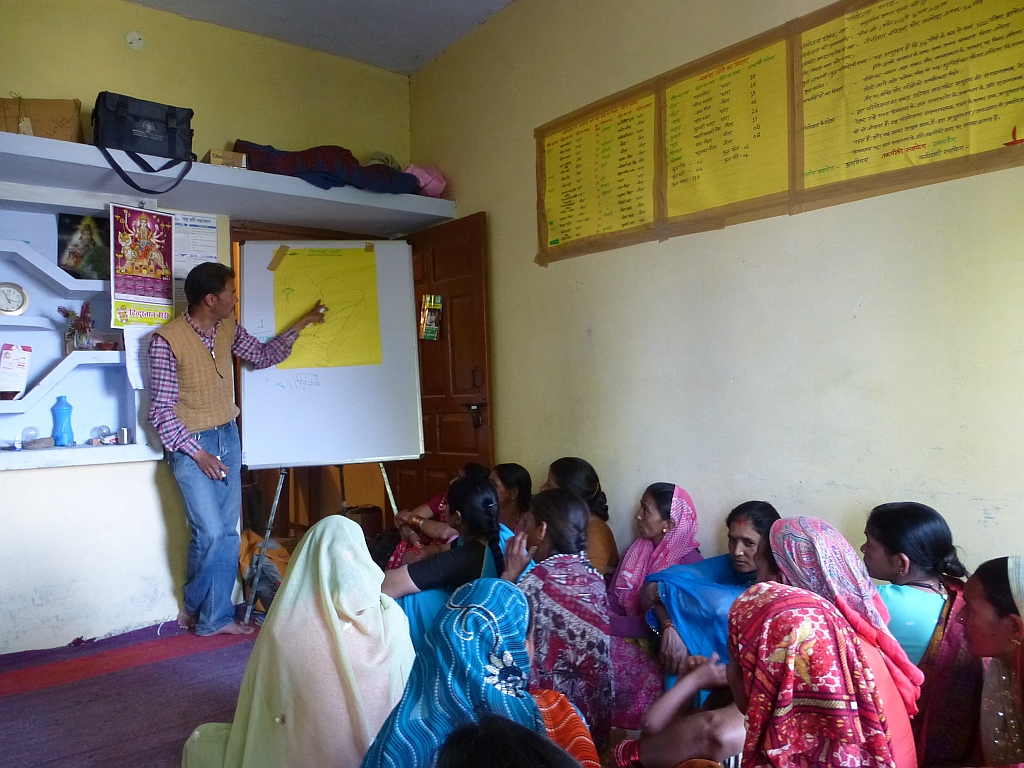The fourteen women and three men were rapt as Pan-'da' explained the intricacies of Himalayan geology. Every now and then, a question would be asked. Pan-'da' would then create an impromptu geological model using a notebook or a whiteboard eraser to explain the concepts. This was essential because the audience had no prior background in geology. Only some of them were even literate.
Pan Singh Bisht is a para-hydrogeologist working with CHIRAG, an organisation that works on spring conservation in the Himalayas. This is a movement spreading across the Himalayan region-an area entirely dependent on the water offered by the springs that flow from the mountain rocks. However this bounty has been decreasing over the last few years. A concern about this decline has inspired several organisations to focus on understanding and arresting it. A key part of this seeking to understand springs is an attempt to share this knowledge with those whose lives depend on spring water.

Pan'da' as he is known to all, is the local manifestation of this attempt. ACWADAM, a hydrogeological organisation based in Pune, has been training government officials and development workers in the essentials of hydrogeology in order to create a nation-wide fleet of people who understand the hitherto-invisible source of their groundwater.
After this training, Pan'da' has built up an extensive working knowledge of springs, their recharge areas and how best to conserve them. He surveys the land surrounding springs, creates geological profiles, identifies the recharge areas of the springs, and does all this while training the village spring management committees (which, incidentally, he has helped form). Later, these management committees sit down with the rest of the villagers and some organisation staff and determine a spring recharge and management plan.
The women and men of these committees do not shrug off the geology lectures. For them, it is not an abstract science- it is the stuff of life. The landmarks on the geology sections tacked up on the walls include their homes, their children's school, and the roads their menfolk take when they leave home. The springs are those that their families have used for generations. The water quality tests offer reasons for their children's illnesses and mysterious phenomena such as clothes stained red when soaked in the water.
Frequently, this discourse on springs is brought alive in unexpected ways.
I was present at a meeting in Mauna village of Ramgarh where Pan Singh was explaining with the help of discharge data and a cross-section map that the village spring was a 'fracture' spring; it owed its generous flow of water to a fissure in the rocks that brought in water from afar. "I know it is so", said Chachaji standing up and making his way to the board. "I have seen the fracture when we built the naula". He then proceeded to add details to the rough sketch on the board.
What will be the result of this? At the least, it will recharge some springs and cause water to flow more reliably than it did before. It will slake the thirst of the villagers, irrigate fields and revive some rivers.
It is however, the social and education aspect that offers the most hope for our future.
Imagine villages with a thorough knowledge of their geology- villages that have as intimate a knowledge of their rocks as they do of their fields. And then speculate on the informed decisions that these people will make when confronted with the question of where to locate a road or site a plantation.
Manju Devi was confident as she presented the results of her spring discharge monitoring. And more impressively, she was convinced of the reasons for this monitoring. If we know how the spring behaves now, she said, we will know how it has changed after we work on it.













